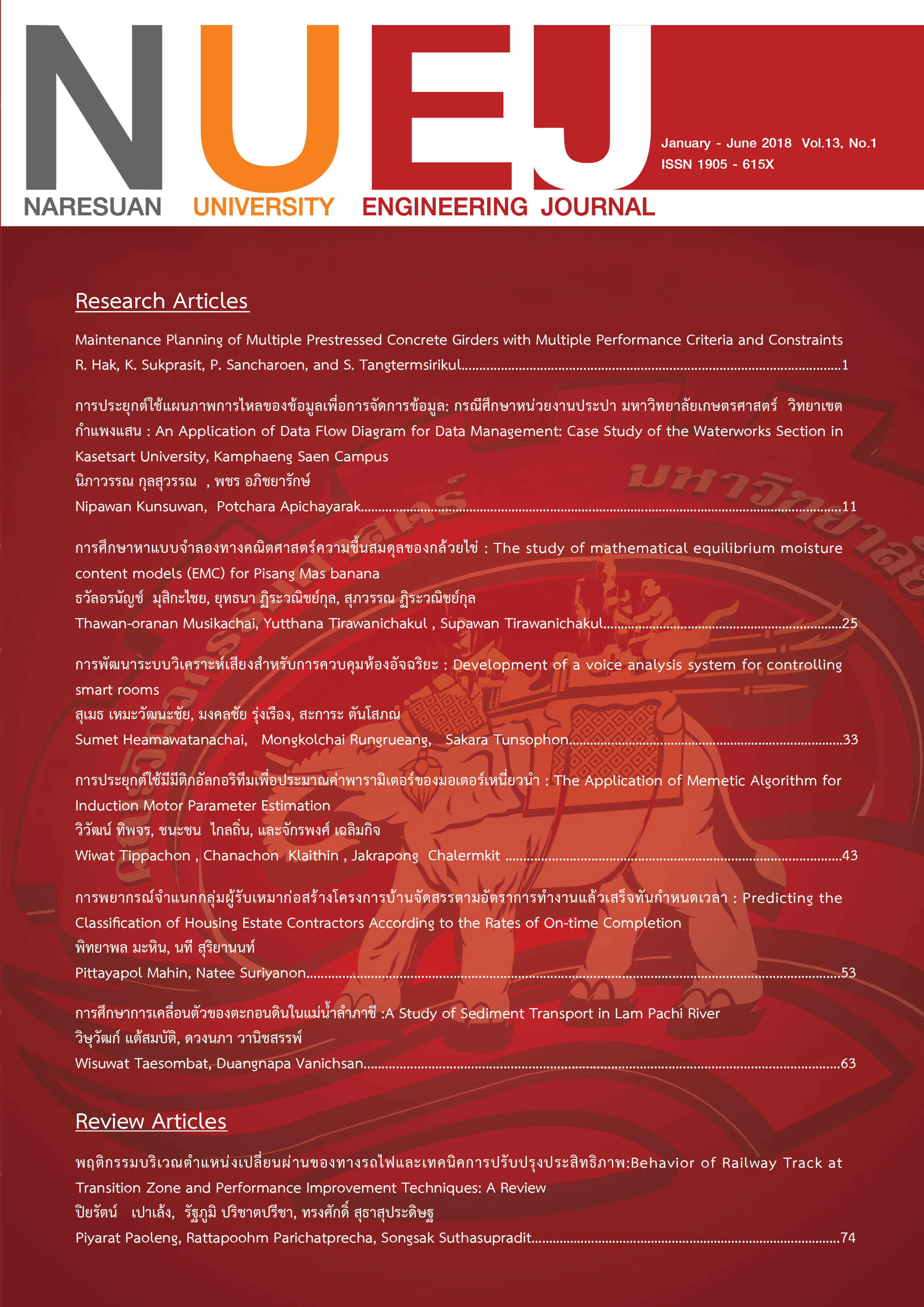The study of mathematical equilibrium moisture content models (EMC) for Pisang Mas banana
Main Article Content
Abstract
The main objective of this research was to evaluate the equilibrium moisture content (EMC) of Pisang Mas banana by static method among surrounding temperature between 45 and 65°C correlated to relative humidity (RH) of 0.11-0.86. And the experimental data were analyzed and simulated by 9 mathematical EMC models (Oswin, GAB, Chung-Pfost, Cauric, Kuhn, Smith, White and Eiring, Modified Smith and Modified Oswin). From the experimental results, they showed that at fixed surrounding temperature the EMC value of the bananas was non-linearly related to the surrounding relative humidity. Moreover at constant RH value the EMC value of the banana was inversely proportional to the surrounding temperature. Due to mathematical EMC model simulation, the criteria decision for getting the most suitable EMC model was determined by the highest coefficient of determination value (R2), the lowest value of root mean square error (RMSE), sum of squared error (SSE) and Chi square (c2). The simulation results stated that the predicted EMC data of GAB model was the best fitting to the experimental EMC data. And finally this simulated GAB model can apply to determine the EMC of Pisang Mas banana in tropical surrounding temperature and relative humidity for maintain quality of shelf life
Keywords : Pisang Mas banana, Evaluation of Equilibrium Moisture Content, Mathematical models, Static method
Article Details
References
Department Of Industrial Promotion. (2016). Benefit of banana. Available at: http://www.thaitechno.net/t1 /knowledge. php?uid=39487.
Kluai Khai. (2017), Banana Information. Availableat:http://www.bananahealthy.com/%E0%B8%81%E0%B8%A5%E0%B9%89%E0%B8%A7%E0%B8%A2%E0%B9%84%E0%B8%82%E0%B9%88/
Pornpun, R. (2016). Nutrition of Thai food (Table). Availableat: http://www.booktime.co.th/new /article_ detail .php?t_id=1403000022#.VGIuYvmsXoE.
Sasiwimon, S., Jamon, S., Samutchai, C. (2016). Banana Thai. Available at: http://www.sc.mahidol ac. th/scpl/banana/LepMueNang.htm.
Chanun, R., Sunate, S. (2012). Determination of Moisture Sorption Isotherm for Hygroscopic Materials, 18(1), 43-51.
Tawarat, T., Somyot, C. (2009). Equilibrium Moisture Content and Drying of Phlai (Zingiber cassumunar Roxb.), Thai society of Agricultural Engineering, 10.
Wasan, J., Thossaporn, C., Sutep C., Chalerm, S. (2012). Comparison of mathematical model equilibrium moisture content for sheet rubber. KKU Engineering Journal, 39(1), 11-21.
Oswin, C. R. (1946). The kinetics of package life. III. The isotherms. Journal of Chemical Industry, 65, 419-423.
Asma, K.B., Nourhène, B.M., & Nabil, K. (2012). Moisture sorption isotherms Experimental and mathematical investigations of orange (Citrus sinensis) peel and leaves. Journal of Food Chemistry, 132, 1728-1735.
Ali, Z., Zahra, K., & Leila, M. (2011). Determination of EMC isotherms and appropriate mathematical models for canola. Journal of Food and Bioproducts Processing, 89, 407-413..
Gokhan, B., Bhagwati, P., & Zhongli, P. (2012). Dynamic vapor sorption isotherms of medium grain rice varieties. Journal of LWT - Food Science and Technology, 48, 156-163.
AOAC. Official method of analysis, 16th ed., (2000). The Association of Official Analytical Chemists. Inc. Arlington, Verginia, USA.
Pfost, H.B., Mourer, S.G., Chung, D.S., Milliken, G.A., (1976). Summarizing and Reporting Equilibrium Moisture Data for Grains. ASEA Paper No. 76-3520. St. Joseph, MI.
Chen, C., Jayas, D.S., (1998). Evaluation of the GAB equation for the isotherms of agricultural products. Trans. ASABE, 41, 1755-1760.
Van der Berg, C., Bruin, S., (1981). Water activity and its estimation in food systems; theoretical aspects. In: Rockland, L.B., Stewart, G.F. (Eds.), Water Activity: Influences on Food Quality Academic Press Inc., New York, pp. 1, 61.
Pak, S.L., Shahab, S., Xiaotao T.B., C. Jim Lim., & Sylvia H.L. (2012). Drying characteristics and equilibrium moisture content of steam-treated Douglas fir (Pseudotsuga menziesii L.). Journal of Bioresource Technology, 116, 396-402.
Chen, C., (2000). Rapid model to determinate the sorption isotherms of peanuts. Journal of Agricultural Engineering Research, 75, 401-408.
A. Iguaz, P. Virseda. (2007). Moisture desorption isotherms of rough rice at high temperatures. Journal of Food Engineering, 79, 794-802.
Castillo, M.D., Martinez, E.J., Gonzalez, H.H.L., Pacin, A.M., & Resnik, S.L., (2003). Study of mathematical models applied to sorption isotherms of Argentinean black bean varieties. Journal of Food Engineering. 60, 343-348.
Smith, S.E., (1947). Sorption of wheat vapour by high polymers. Journal of the American Chemical Society, 69, 646-651.
Neila, B., Nourhene, B., & Nabil, K. (2008). Moisture desorption adsorption isotherms and isosteric heats of sorption of Tunisian olive leaves (Olea europaea L.). Journal of industrial crops and products, 28, 162-176.
Guggenheim, E. A. (1966). Application of statistical mechanics. Oxford Clarendon Press.
Anderson, R. B. (1946). Modification of the Brunauer, Emmett and Teller equation.Journal of the American Chemical Society, 68, 686-691
De Boer, J. H. (1953). The dynamic character of adsorption. Oxford Clarendon Press.
Rockland, L.B., Stewart, G.F., (1981). Water Activity Influence on Food Quality. New York:
Acedemic Press.


